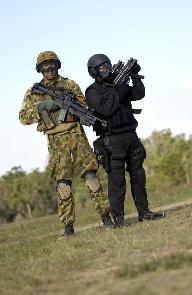| Special Operations Command | |
|---|---|
 | |
| Active | 2003–present |
| Country | Australia |
| Role | Special operations |
| Size | 2,050 (active in 2014) [1] 750 (reserve in 2014) [1] |
| Part of | Australian Defence Force |
| Headquarters location | General John Baker Complex, Bungendore [2] |
| Mottos | Acies Acuta (The Cutting Edge) |
| Commanders | |
| Current commander | Major General Garth Gould |
The Special Operations Command (SOCOMD) is an Australian Defence Force command that was established on 5 May 2003 to unite all of the Australian Army's special forces units and by 2008 was fully operational. [3] [4] [5] Australia's Special Operations Command is of equivalent status to Australia's Fleet, Forces and Air Commands. [3] It is modelled on the equivalent commands in the United States and British military forces, and is led by a major general as Special Operations Commander Australia (SOCAUST).
Contents
- History
- Organisation
- Special Operations Commander Australia (SOCAUST)
- See also
- Notes
- Further reading
The origins of SOCOMD began in 1979 with the army creating a small Directorate Special Action Forces—Army. On 13 February 1990, Headquarters Special Forces was established, which was renamed in 1997 to Headquarters Special Operations and in 2003 to Special Operations Headquarters or SOCOMD. [5] [6] [7]

